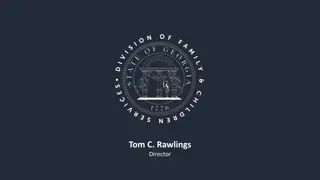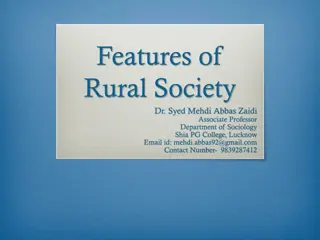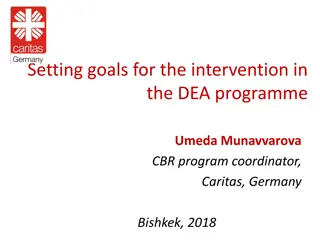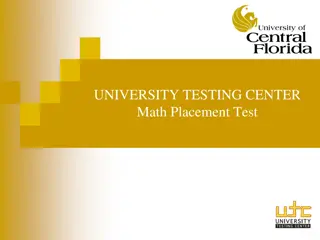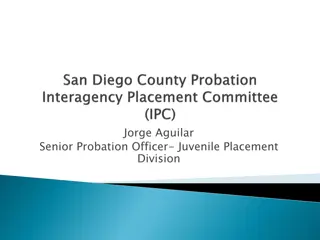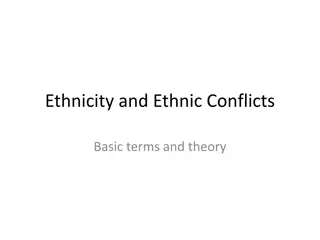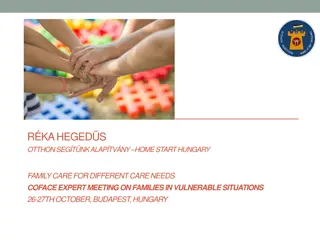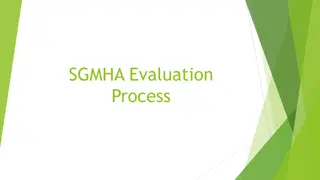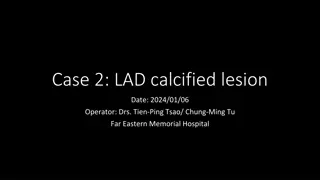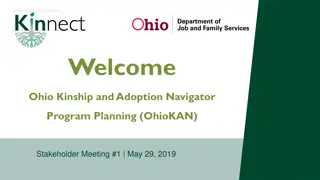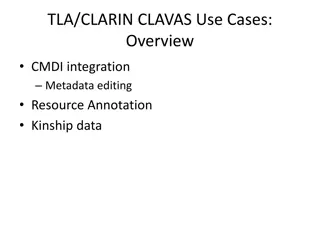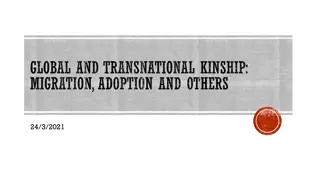Pre- and Post-Placement Intervention Approach with Kinship Families
This research study explores direct service practices with kinship families, focusing on themes post Breakthrough Series Collaborative. The study involves analyzing case reviews and conducting personal interviews to identify emerging themes in child protection work with kinship caregivers. The purpose is to enhance understanding and improve support for kinship families during child placement processes.
Uploaded on Sep 15, 2024 | 0 Views
Download Presentation

Please find below an Image/Link to download the presentation.
The content on the website is provided AS IS for your information and personal use only. It may not be sold, licensed, or shared on other websites without obtaining consent from the author. Download presentation by click this link. If you encounter any issues during the download, it is possible that the publisher has removed the file from their server.
E N D
Presentation Transcript
Pre- and Post- Placement Intervention Approach with Kinship Families: Role for Child Protection Workers Priscilla Gibson, Ph.D., Katie Haas Shweta Singh School of Social Work, University of Minnesota 1
Pre- and Post- Placement Intervention Approach with Kinship Families: Role for Child Protection Workers Priscilla Gibson, Ph.D. Katie Haas Shweta Singh School of Social Work University of Minnesota St. Paul, MN 55108 2
Research Study A qualitative research project reviewing kinship care practices at Ramsey County Human Services from September, 2008 to May, 2009. Elements of practice examined include: Father involvement Cultural issues Kinship search process 3
Purpose of Study To examine components of direct service practice with kinship families, seeking themes since the Breakthrough Series Collaborative implemented in 2004 and 2005. The qualitative findings reported here were part of a larger mixed-method designed that was conducted to further explore previous findings regarding the kinship search. The original research project was an evaluation of the Casey s Foundation BSC conducted from October 2006 to May, 2008. 4
Measurement Tool Case reviews were analyzed using a questionnaire 30 items long covering: Demographic information Four areas of exploration: Father involvement Cultural issues Kinship search process History of the case Notable practices used by workers 5
Eligibility Criteria Case eligibility was determined if the following criteria was met: Child Protection or Adoption/Guardianship case Kinship caregiving relationship(s) Received services during the BSC of 2004, 2005 Sought cases that were active before and/or after the BSC as well. Case closed and all information documented: Only one case was open at the time of review 6
Data Collection Data collected through: Extensive reviews of 36 kinship cases Personal interviews with Child Protection workers Findings discussed here are from case reviews only. 7
Emerging Themes Four themes emerged as pervasive with kinship families: Placement disruptions Children needing special services Characteristics of biological parents Supportive services to caregivers Note that many cases experienced several themes simultaneously, as well as subsets of the themes within the same kinship families. 8
Placement Disruptions Frequent placement disruptions including: Sequential kin placements with multiple relatives (26) Sequential stranger foster care (10) Residential treatment facilities (15) Incarceration for criminal acts (6) Return to a former foster care placement (2) Disruptions were largely preceded by escalating behavioral problems in the child(ren). 9
Children Needing Special Services RC workers documented five types of problems children were experiencing, which typically led to referrals for services: (a)Mental health diagnoses (24) (b)Learning disabilities (6) (c) Physical health concerns (2) (d) Running away or other behavioral issues (26) (e) Prenatal exposure alcohol or drugs (10) 10
Characteristics of Biological Parents Workers inclusively documented characteristics of both mothers and fathers of children in kinship care. Both parents experienced similar problems, including: a)Incarcerations: fathers (12), mothers (6) b) Chemical abuse: mothers (19), fathers (5) c)Homelessness/highly mobile: fathers (9), mothers (7) d) Mental illness diagnoses: mothers (8), fathers (0) e)Lack of paternity information: fathers (6) f)History of CPS involvement: mothers (9) 11
Supportive Services to Caregivers In addition to regular visits with County case managers, RC workers recorded three types of services caregivers were referred to: a)Counseling (specifically directed at caregivers of the kin family unit) (12) b)Training for caregivers as parents (4) c)Financial services beyond the normal subsidies (9) 12
Correlates in Existing Literature Placement disruptions: Kinship care is less likely to disrupt than stranger foster care placement, but research about the extent of this is inconclusive. Children needing special services: Strong presence of special needs in areas of behavioral and mental health. Potentially linked to prior trauma High rates of referrals for counseling services, but few were in-home or serving the whole kin family unit. 13
Correlates in Existing Literature Characteristics of biological parents: Evidence of workers including fathers and fathers kin corresponds to best practices in BSC and other literature of inclusive kinship caregiving. Support services to caregivers: Disparity between formalized supports for kin vs. stranger foster caregivers Sparse research about best practices in supporting kinship care families. The kinship family unit was viewed as the support service, rather than in need of supportive services. 14
Implications for practice Direct practice approach for CPS workers to intervene with families in formal kinship care Pre-placement interventions (occurs before child is living with caregiver): 1.Provide psycho-educational information about the possible reactions of children in kinship care arrangements. 2.Provide structured pre-placement visits. 3.Incorporate problem-solving strategies between caregiver and child(ren). 15
Implications for practice Direct practice approach for CPS workers to intervene with families in formal kinship care Post-placement interventions (occurs once child is living with the caregiver): 1.Inform of challenges. 2.Normalize challenges. 3.Develop a plan to deal with common challenging situations that might develop. 16

 undefined
undefined










